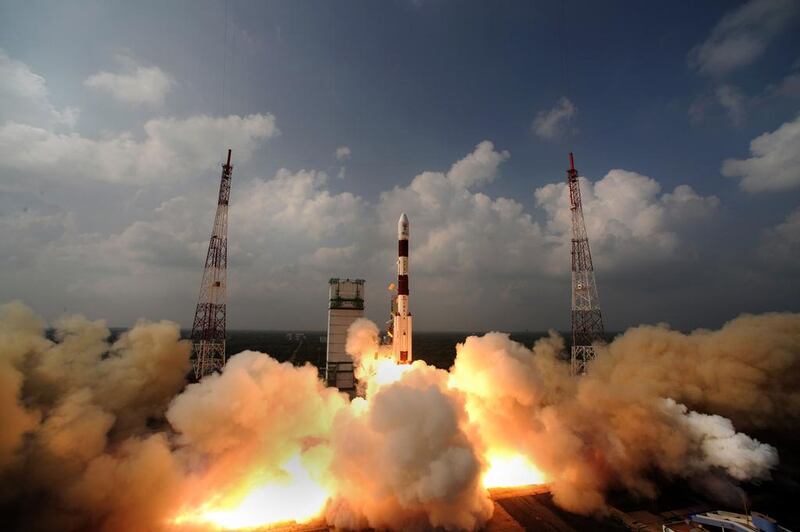India’s successful launch of a spacecraft to Mars this month has brought the country’s space ambitions and its advanced technologies in the field into focus.
The Indian Space Research Organisation’s (ISRO) mission has prompted divided opinions. Some critics question whether the country – which has extremely high levels of poverty and malnutrition across its population – should have spent US$72 million on the project, even though that amount is considered relatively low for such a enterprise.
The annual budget of the ISRO is just $700m, or 0.038 per cent of India’s GDP. By contrast, this year the US’s Nasa will spend $16.5 billion, about 0.1 per cent of the United States’ GDP
Others, meanwhile, argue that the mission could provide a huge boost to the development of India’s space technology industry, which would in turn bring enormous and much-needed benefits to its economy as India puts itself in a position to grab a larger share of the $300bn worldwide space market.
“The recent Mars mission has put the global spotlight on India’s space programme,” says Susmita Mohanty, the chief executive and co-founder of Earth2Orbit, India’s first private sector space company, which is striving to commercialise the country’s space capabilities.
“It will likely attract other nations, even private entrepreneurs, to collaborate and launch joint missions.”
The spacecraft, which was launched from the Satish Dhawan Space Centre on India’s east coast on November 5, is set to travel 780 million kilometres for 300 days before reaching the red planet’s orbit next year. India’s would become the fourth space agency to reach Mars if the mission is successful. The US, Russia and Europe Union are the three that have already achieved that feat. India’s space programme began in 1962 and was institutionalised under the ISRO in 1969.
Some commentators have described the mission as upping the ante in the Asian space race, as it could give India a victory over China and other nations in space exploration. A similar mission by China was unsuccessful in 2011, when its spacecraft failed to leave Earth’s orbit. More than half of all missions to Mars have not succeeded. There were concerns that the Indian operation could be jeopardised when on Monday a problem with the spacecraft’s liquid fuel thruster meant it fell short of its intended velocity target but the ISOR said later the glitch had been resolved.
India’s prime minister Manmohan Singh described the Mars Orbiter Mission, or Mangalyaan in Hindi, as “the most complex space mission of the country”. He said the launch was testimony to the ISRO’s “mastery of the launch vehicle technology”.
Still, more than two-thirds of India’s population lives off just $2 a day and economic growth is slowing to a decade low of 5 per cent for the past financial year, well below the 8 per cent or so needed to create enough jobs in a country with more than 1.2 billion inhabitants.
Some believe the development of Indian prowess in space technology could help India to evolve and grow and argue that India’s technology is already playing a critical role in the country’s progress.
“The Indian space programme is already helping the Indian economy,” says Ms Mohanty.
“It trickles down to the common man in very many ways whether you are a fisherman or a farmer or a truck fleet operator.
“India’s satellites are used for a wide variety of Earth[-bound] applications covering just about every sector you can imagine.”
The ISRO says its space programme is focused on developing technologies that benefit society.
“From the beginning, space activities in the country concentrated on achieving self-reliance and developing capability to build and launch communications satellites for television broadcast, telecommunications and meteorological applications, remote sensing satellites for management of natural resources,” according to the agency.
K Radhakrishnan, the chairman of the ISRO, has said the technologies developed for the Mars mission could also be applied to other tasks, such as forecasting cyclones.
Ms Mohanty says there is much more that needs to be done before the industry can really take off.
“In my view, India will need to overhaul its space policy to make it more outward looking, more extroverted,” she says.
“For many decades, our focus had appropriately been on technology independence and space applications to improve the lives of our people here on Earth.
“While this pragmatic approach should continue, India also needs to take steps to grow its industry and bring it up to world standards to compete internationally,” she says.
“The ISRO engages somewhere between 400 to 500 companies, big and small, that supply components and sub-systems for building satellites and rockets,” Ms Mohanty adds.
“However, to have a ‘real industry’ that has scale, scope and ambition as you find in the United States and Europe, India would have to start privatising its satellite making, transponder leasing and rocket building activities and let its vendor capabilities evolve… thus making Indian companies capable of competing in the international space marketplace.”
Zee Learn is the educational division of the Indian conglomerate Essel Group, which has been actively trying to encourage science education for Indian children in an effort to help to boost scientific and technological innovation – including in the area space exploration – in the country.
“Space technology rules supreme as the highest order of science, and we will make an ardent effort to make our children shine as the rising stars in the horizon,” says Sindu Aven, the head of academic design and content at Zee Learn.
“In today’s context, if there is one predominant thing that leads to the promise of a nation, it is science and innovation,” she says.
“There is other no other substitute to progress and prosperity. Even our age-old agricultural pursuits merit a strong groundwork of scientific research and technological innovations. That substantiates the point how indispensable science is, as of today, that is. India has good reason to eye space technology as a future ambition,” Ms Aven adds.
“It goes without saying, it’s an economic revolution.”
business@thenational.ae





